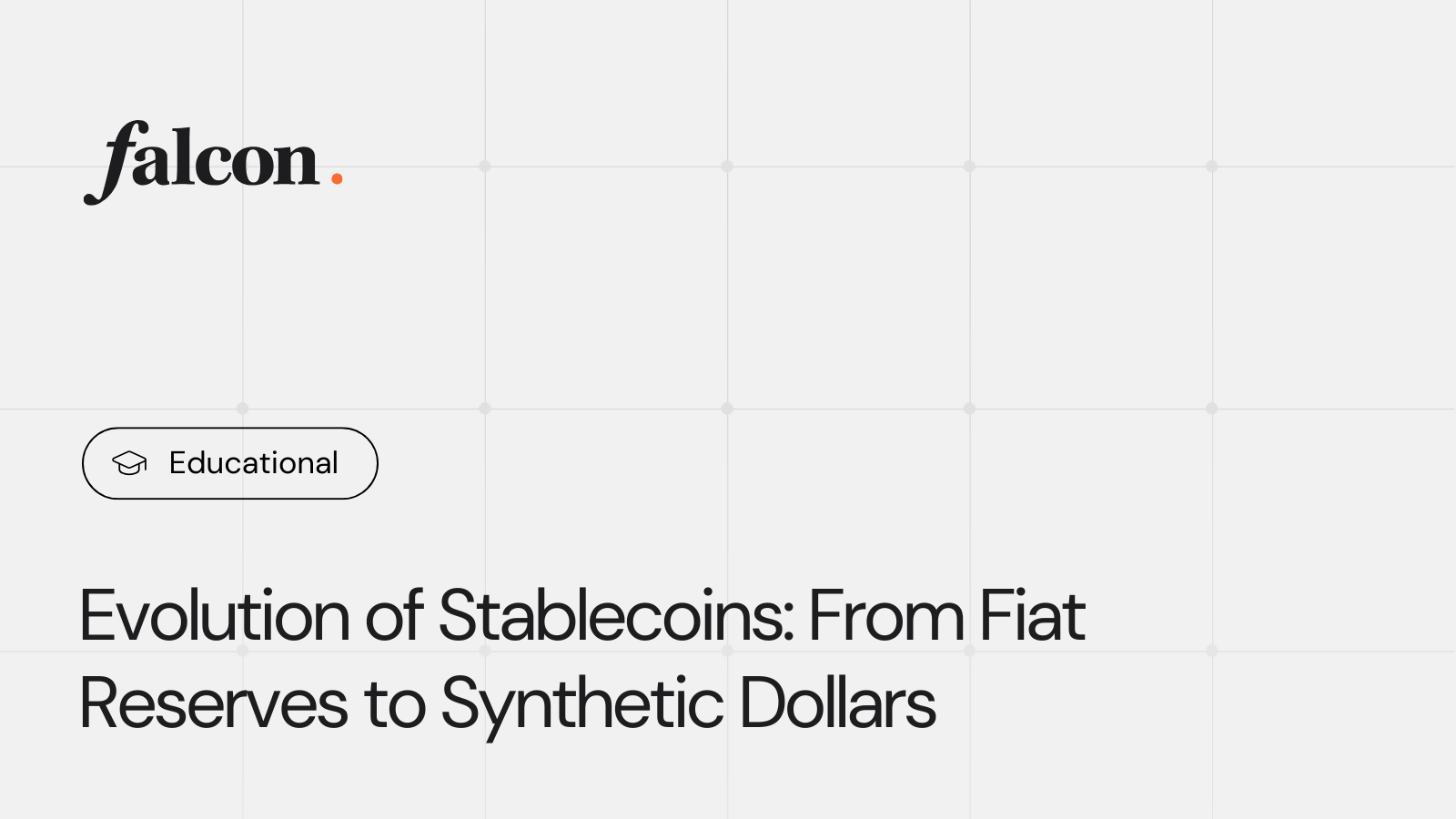Tracing the Evolution of Stablecoins: From Fiat Reserves to Synthetic Dollars
Updated • 15 Aug 2025
Published • 10 May 2025
5 mins

Stablecoins play a critical role in bridging traditional finance and blockchain ecosystems, offering users a reliable store of value amid price volatility. This article chronicles the progression of stablecoin design, from the earliest fiat-backed tokens to modern synthetic dollar protocols such as Falcon Finance, highlighting how each innovation addresses trade-offs among stability, transparency, and yield.
The Dawn of Fiat-Backed Stablecoins
In mid-2014, RealCoin rebranded as Tether (USDT), creating the first widely used stablecoin backed by off-chain U.S. dollar reserves. By pegging USDT 1:1 to the dollar and holding corresponding fiat collateral, Tether enabled traders to move value on-chain without relying on banking rails. Within months, USDT rose to prominence, demonstrating the demand for a digital dollar substitute.
Two years later, in 2018, the Centre consortium, formed by Circle and Coinbase, introduced USD Coin (USDC). Launched publicly in October 2018, USDC distinguished itself with monthly reserve attestations by Grant Thornton, one of the world’s leading audit firms. This transparency initiative aimed to bolster confidence in its fully reserved, fiat-collateralized model.
The Emergence of Crypto-Collateralized Stablecoins
By late 2017, a new class of “pure” on-chain stablecoins appeared. In December 2017, MakerDAO launched DAI, a token with 1:1 value to USD minted via overcollateralized loans of Ethereum (ETH) and governed by the decentralized MakerDAO community. Overcollaterization ensured sufficient stability for DAI as the value of underlying collateral (ETH) fluctuated due to drastic crypto price changes.
Unlike fiat-backed coins, DAI’s peg was maintained by smart-contract rules: users locked ETH to mint DAI, and collateral auctions (where under-collateralized collateral is sold to bidders to restore the peg) healed under-collateralization.
The Hybrid Era: Fractional-Algorithmic Designs
Seeking greater capital efficiency, a project called Frax Finance introduced the FRAX token in December 2020. As the first fractional-algorithmic stablecoin, FRAX combined on-chain collateral with algorithmic supply adjustments. Its dynamic collateral ratio adapted in real time to preserve the peg while reducing collateral requirements. Although the project did not manage to receive substantial traction, FRAX (relaunched in 2025 as frxUSD to offer yield generation) remains the oldest live algorithmic stablecoin.
The Terra Luna and UST Collapse
Launched in April 2021 by Terraform Labs, the Terra protocol paired its algorithmic stablecoin UST with the native token LUNA, leveraging attractive yields to drive rapid adoption. At its peak, UST commanded over $18 billion in market capitalization and ranked among the top stablecoins.
Yet its underlying mint-and-burn mechanism, allowing holders to freely swap UST for $1 worth of LUNA, created a single point of failure. When market sentiment lost its momentum, the arbitrage loop inverted into hyperinflationary pressure on LUNA.
In May 2022, Terra’s algorithmic stablecoin UST suffered a dramatic depeg, triggering mass redemptions that flooded the market with newly minted LUNA and caused both tokens to collapse in value. This crisis underscored the perils of designs that rely solely on a native-token stabilizer and reinforced the necessity for diversified collateralization and rigorous risk controls in stablecoin architectures.
The Rise of Synthetic Dollar Protocols
Synthetic dollar protocols represent a shift towards financial engineering on-chain. Ethena Labs launched the USDe token in February 2024. Unlike predecessors, a new project started using delta-neutral strategies for yield: users deposit popular stablecoins or Ethena’s governance tokens ENA, and receive USDe, while the protocol shorts equivalent notional amounts in perpetual futures to hedge price exposure. Without relying on fiat reserves, USDe achieves its peg through continuous hedging and automated rebalancing.
At the same time, in September 2024, the MakerDAO community introduced Sky Dollar (USDS) as part of its Endgame upgrade. While retaining vault-based collateral (including crypto assets, real-world assets, and other stablecoins), Sky Dollar incorporates advanced governance-driven rate adjustments and layered risk parameters, further decentralizing peg maintenance.
Falcon Finance: Next-Generation Synthetic Dollars
Falcon Finance builds on the synthetic dollar concept by delivering institutional-grade yields via a diversified strategy suite and refined incentive system. It deploys collateral across multiple yield engines:
- Negative funding rate arbitrage. The protocol shorts perpetual futures when funding rates are negative, capturing income from long-position holders while maintaining delta-neutral exposure.
- Cross-exchange price arbitrage. Falcon searches for price discrepancies between centralized and decentralized venues, executing simultaneous trades to secure risk-free profits.
- Native and liquid staking. Altcoins deposited by users get allocated to rotating positions to maximize uptime and rewards.
Among other differences of Falcon is the broadened list of cryptocurrencies accepted as collateral, adding major altcoins to stablecoins. Falcon’s Boosted Yield feature further enhances returns: users who lock USDf for 3, 6, or 12 months receive a 5%, 25%, or 50% bonus on base APY.
Dynamic rebalancing, over-collateralization buffers, and real-time risk monitoring underpin Falcon’s commitment to delivering sustainable yet competitive yields.
Comparing Reserve-Backed and Synthetic Protocols
Reserve-backed coins, exemplified by USDT and USDC, have established dominance with over $200 billion in combined reserves, as of May 2025. Their custodial simplicity and regulatory clarity have earned widespread trust.
Synthetic dollar protocols like Falcon, Ethena or Sky further develop this model by implementing on-chain hedging, arbitrage, and dynamic collateral strategies. Falcon Finance also offers full transparency, composability, and the potential for higher yields.
Although synthetic protocols have yet to rival the sheer scale of USDT and USDC, they present a compelling “golden middle” that balances stability, risk, and return. These solutions may become essential complements to traditional reserve-backed stablecoins, or even threaten their supremacy. Awareness and adoption of synthetic dollar protocols in the crypto community is growing: Its USDf token's supply surpassed $350 million in TVL within two weeks after its public launch on April 30, 2025.
Looking Ahead
The stablecoin landscape continues to evolve, driven by innovations in collateralization, governance, and financial engineering. Synthetic dollar protocols signify a forward-looking approach to on-chain money—one that prioritizes transparency, programmability, and competitive yields. Whether they ultimately rival or coexist with fiat-backed counterparts, these designs underscore the diverse pathways for achieving a reliable, decentralized dollar on blockchain networks.